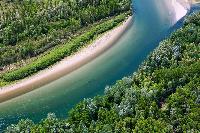Old-Drava project site launched

It offers information on restoring the Old-Drava oxbow
WWF Hungary and WWF Croatia have launched a new website dedicated to the restoration of the trans-border Old-Drava oxbow on the Old Drava River. The site will soon have a Hungarian and Croatian language version too.
The oxbow area is part of the cross border biosphere reserve Mura-Drava-Danube that is also called The Amazon of Europe because of its biodiversity. Its restoration is the first LIFE+ funded cross-border project of Hungary and Croatia. It is also co-funded by WWF DCP’s seven-year partnership with Coca-Cola.
An oxbow is a U-shaped body of water formed by a river’s meanders. During the regulations of the Drava in the 20th century, many of these meanders were cut from the river and now do not communicate with it.
The longest oxbow on the left side of the river is the Old-Drava. It is situated some kilometres upstream from the Hungarian towns of Barcs. The decreased water levels of the Drava River and the abandoned fishing infrastructure pose a threat to the ecological status of floodplain forests along it, which have started degrading in the past decades.
The four-year oxbow restoration project started in 2014. It will improve both the water regime of the oxbow and the biodiversity of the floodplain forests. This will be done by stabilizing water levels with water retention structures in the oxbow, which will improve the water supply from the main course of the river. Native tree and shrub species will also be planted to increase the diversity of forest habitats.
There is significant human activity within the area, and fishing places a considerable pressure on nature. This is why the project will also involve local fishermen in removing abandoned fishing platforms and other litter from the oxbow. Additionally, communication work will raise public awareness on the importance of wetlands.
The project leader is the Danube-Drava National Park Directorate. Other WWF partners are the Municipality of Pitomaca, the Virovitica-Podravina County's Regional Development Agency, the Public Institution for Managing Protected Nature in the Virovitica-Podravina County, and the Angling Association of Somogy County.
More on the area
The Drava River has been least changed by human activity from all rivers in Hungary. This makes it one of Europe’s treasure troves of biological diversity. Spanning Austria, Croatia, Hungary, Serbia and Slovenia, the lower courses of the Drava and related sections of the Mura and Danube are among Europe's most ecologically important riverine areas. This is why they are called the "Amazon of Europe."
These habitats are home to the highest density of white-tailed eagle breeding pairs in Europe, as well as other endangered species such as the little tern, black stork, beaver, otter and the nearly extinct ship sturgeon. Every year, some 250,000 migratory waterfowl use the rivers to rest and feed.
In addition to the high degrees of biodiversity, the river and its floodplain areas are vital to the people who live there. Local fishermen rely on fish populations for their livelihoods. Moreover, the extensive floodplains lower flood related risks, guarantee favourable groundwater conditions and the self-purification of water. This is essential for drinking water supplies, forests and agriculture.
If you want to visit the area, you can find instructions on how to reach the Old-Drava oxbow and the Black Poplar study trail here.





